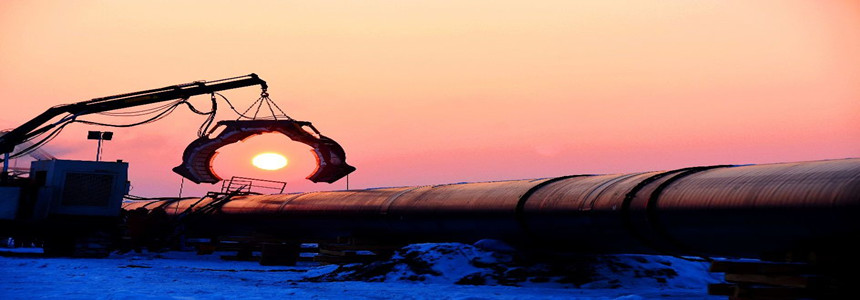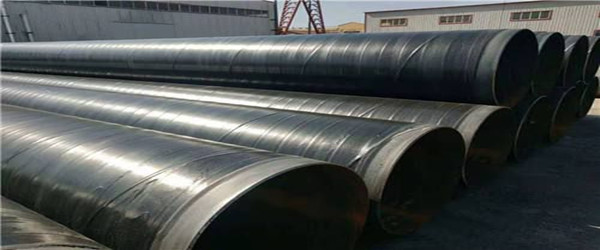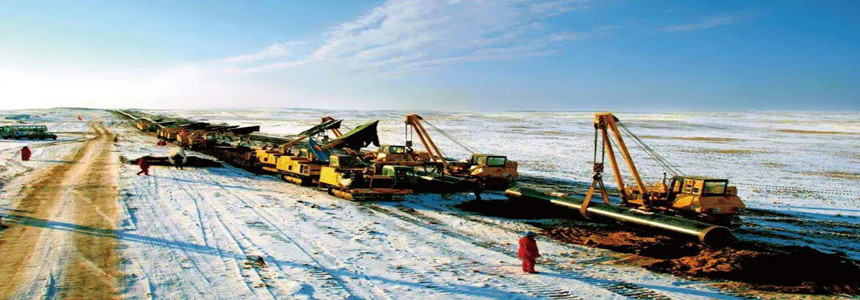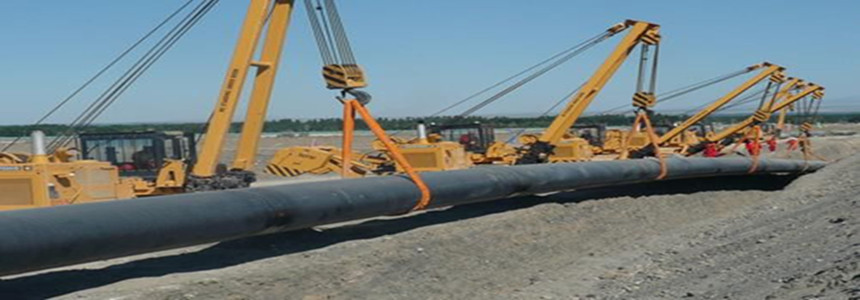Precautions for oil pipeline construction
Precautions for oil pipeline construction
Do you understand the safety knowledge of long-distance oil pipeline construction?
With the continuous development of the economy, oil construction enterprises continue to expand the installation scale of oil pipelines. However, oil has many disadvantages in the process of transportation and production, such as toxic, harmful, flammable, and explosive. So, what should be done to ensure safe production during the construction of long-distance petroleum pipelines?

1. Material and equipment inspection
1. Before construction, the factory certificate, quality certificate and material certificate of the materials and equipment used in the project should be checked, and re-inspection should be conducted when there is any doubt about their quality.
2. Steel pipes should be checked for dimensional deviations such as outer diameter, wall thickness, and ellipticity according to manufacturing standards, and the surface must be free of cracks, scars, folds, and other defects whose depth exceeds the nominal wall thickness deviation.
3. If there are defects such as scratches, pits, arc burns, ovality exceeding the standard, deformation or flattening, the steel pipe should be inspected, classified and treated.
4. Before installing the line valve, visual inspection, valve opening and closing inspection and water pressure test should be carried out.

2. Handling, transportation and storage of materials and anti-corrosion pipes
1. The anti-corrosion pipe shall not damage the anti-corrosion layer, and a special sling bent pipe that does not damage the nozzle shall be used.
2. The safety distance between any part of the construction machinery and equipment and the overhead power line during driving, lifting, loading and unloading shall comply with safety regulations.
3. The transportation of anti-corrosion pipes should comply with the relevant regulations of the transportation department. Thrust baffles should be installed between the trailer and the cab, and the uprights should be firm.
4. Before loading the vehicle, check the anti-corrosion grade, material and wall thickness of the anti-corrosion pipe. It is not suitable to mix anti-corrosion pipes of different anti-corrosion grade, material and wall thickness.
5. When transporting anti-corrosion pipes, securely tie them and take protective measures for the anti-corrosion layer. Between the anticorrosion tube and the frame or column, between the anticorrosion tube, and between the anticorrosion tube and the bundling rope, a rubber sheet or other soft material liner should be set, and the bundling rope should be covered with a rubber tube or other soft pipe sleeve. Protective measures shall be taken for the transportation of bent pipes, and the transportation of insulated pipes shall be carried by a transportation truck equipped with a flexible pad.
6. The warehouse of flammable and explosive materials shall be equipped with fire extinguishing equipment according to relevant standards.
7. After anti-corrosion pipes arrive at the construction site, protective measures should be taken when the open storage time exceeds 3 months.

3. Excavation of pipe trenches
1. When excavating a pipe trench slope with a depth of more than 5m, slow down slope, support or stepped excavation measures should be taken according to the actual situation.
2. Before excavating pipe trenches, the construction personnel should be explained about the distribution of underground facilities. Within 5m on both sides of the underground facility, manual excavation should be used, and protective measures should be taken for the excavated underground facility. For important underground facilities, the consent of the management department should be obtained before excavation, and excavation should be conducted under their supervision if necessary.
3. The pipe trench excavated by blasting should be completed before pipe laying. The blasting operation shall be undertaken by a unit with blasting qualification. The blasting operation shall establish safety measures, stipulate the blasting safety distance, and shall not threaten the safety of nearby residents, pedestrians, and above-ground and underground facilities. For important facilities that may be affected, the relevant departments and personnel should be notified in advance, and safety protection measures should be taken before blasting.
4. When excavating pipe trenches across roads, rivers, densely populated areas, etc., appropriate safety measures shall be taken and warning signs, signal lights, warning objects, etc. shall be provided.

4. Ditch and backfill of pipeline
1. Before going down the ditch, the depth of the pipe ditch should be reviewed to remove foreign objects such as landslides, stones, water, ice and snow.
2. Pipes should be drained using lifting equipment such as pipelayers, and non-lifting equipment such as bulldozers or crowbars must not be used. Nylon slings or rubber roller baskets should be used for spreaders, and wire ropes should not be used directly.
3. When the pipeline goes down the trench, the operation should be directed by a special person, and effective measures should be taken to prevent the pipeline from rolling the trench, and care should be taken to avoid hitting the trench wall to prevent scratching the anti-corrosion layer.
4. During the pipeline ditching process, an EDM leak detector should be used to check the pipeline anti-corrosion layer. The detection voltage should meet the design and current relevant standards, and any damage or pinholes should be repaired in time.
5. Generally, the pipelines should be backfilled in time after going down the ditch. Before backfilling, the water in the ditch should be removed. The mountainous areas, high water level sections, densely populated areas and rainy season construction should be backfilled immediately.
6. For the trenches that may be washed by the flood or not foamed after backfilling, measures such as compacting trenches, drainage or sand bags should be taken to prevent erosion and pipeline floating.

Do you understand the safety knowledge of long-distance oil pipeline construction?
With the continuous development of the economy, oil construction enterprises continue to expand the installation scale of oil pipelines. However, oil has many disadvantages in the process of transportation and production, such as toxic, harmful, flammable, and explosive. So, what should be done to ensure safe production during the construction of long-distance petroleum pipelines?

1. Material and equipment inspection
1. Before construction, the factory certificate, quality certificate and material certificate of the materials and equipment used in the project should be checked, and re-inspection should be conducted when there is any doubt about their quality.
2. Steel pipes should be checked for dimensional deviations such as outer diameter, wall thickness, and ellipticity according to manufacturing standards, and the surface must be free of cracks, scars, folds, and other defects whose depth exceeds the nominal wall thickness deviation.
3. If there are defects such as scratches, pits, arc burns, ovality exceeding the standard, deformation or flattening, the steel pipe should be inspected, classified and treated.
4. Before installing the line valve, visual inspection, valve opening and closing inspection and water pressure test should be carried out.

2. Handling, transportation and storage of materials and anti-corrosion pipes
1. The anti-corrosion pipe shall not damage the anti-corrosion layer, and a special sling bent pipe that does not damage the nozzle shall be used.
2. The safety distance between any part of the construction machinery and equipment and the overhead power line during driving, lifting, loading and unloading shall comply with safety regulations.
3. The transportation of anti-corrosion pipes should comply with the relevant regulations of the transportation department. Thrust baffles should be installed between the trailer and the cab, and the uprights should be firm.
4. Before loading the vehicle, check the anti-corrosion grade, material and wall thickness of the anti-corrosion pipe. It is not suitable to mix anti-corrosion pipes of different anti-corrosion grade, material and wall thickness.
5. When transporting anti-corrosion pipes, securely tie them and take protective measures for the anti-corrosion layer. Between the anticorrosion tube and the frame or column, between the anticorrosion tube, and between the anticorrosion tube and the bundling rope, a rubber sheet or other soft material liner should be set, and the bundling rope should be covered with a rubber tube or other soft pipe sleeve. Protective measures shall be taken for the transportation of bent pipes, and the transportation of insulated pipes shall be carried by a transportation truck equipped with a flexible pad.
6. The warehouse of flammable and explosive materials shall be equipped with fire extinguishing equipment according to relevant standards.
7. After anti-corrosion pipes arrive at the construction site, protective measures should be taken when the open storage time exceeds 3 months.

3. Excavation of pipe trenches
1. When excavating a pipe trench slope with a depth of more than 5m, slow down slope, support or stepped excavation measures should be taken according to the actual situation.
2. Before excavating pipe trenches, the construction personnel should be explained about the distribution of underground facilities. Within 5m on both sides of the underground facility, manual excavation should be used, and protective measures should be taken for the excavated underground facility. For important underground facilities, the consent of the management department should be obtained before excavation, and excavation should be conducted under their supervision if necessary.
3. The pipe trench excavated by blasting should be completed before pipe laying. The blasting operation shall be undertaken by a unit with blasting qualification. The blasting operation shall establish safety measures, stipulate the blasting safety distance, and shall not threaten the safety of nearby residents, pedestrians, and above-ground and underground facilities. For important facilities that may be affected, the relevant departments and personnel should be notified in advance, and safety protection measures should be taken before blasting.
4. When excavating pipe trenches across roads, rivers, densely populated areas, etc., appropriate safety measures shall be taken and warning signs, signal lights, warning objects, etc. shall be provided.

4. Ditch and backfill of pipeline
1. Before going down the ditch, the depth of the pipe ditch should be reviewed to remove foreign objects such as landslides, stones, water, ice and snow.
2. Pipes should be drained using lifting equipment such as pipelayers, and non-lifting equipment such as bulldozers or crowbars must not be used. Nylon slings or rubber roller baskets should be used for spreaders, and wire ropes should not be used directly.
3. When the pipeline goes down the trench, the operation should be directed by a special person, and effective measures should be taken to prevent the pipeline from rolling the trench, and care should be taken to avoid hitting the trench wall to prevent scratching the anti-corrosion layer.
4. During the pipeline ditching process, an EDM leak detector should be used to check the pipeline anti-corrosion layer. The detection voltage should meet the design and current relevant standards, and any damage or pinholes should be repaired in time.
5. Generally, the pipelines should be backfilled in time after going down the ditch. Before backfilling, the water in the ditch should be removed. The mountainous areas, high water level sections, densely populated areas and rainy season construction should be backfilled immediately.
6. For the trenches that may be washed by the flood or not foamed after backfilling, measures such as compacting trenches, drainage or sand bags should be taken to prevent erosion and pipeline floating.





